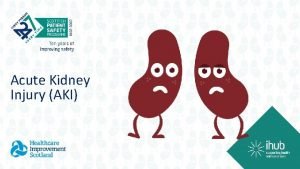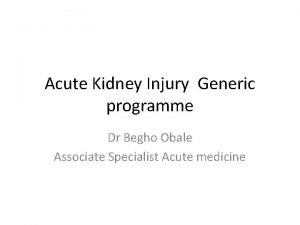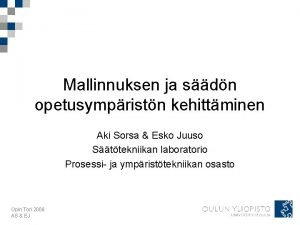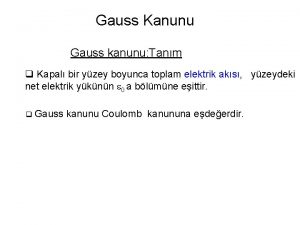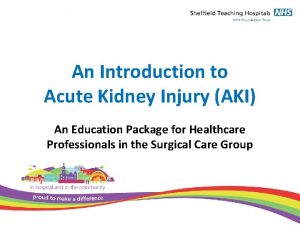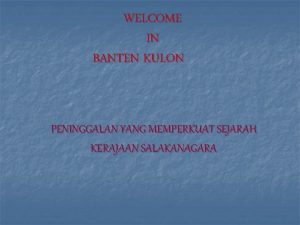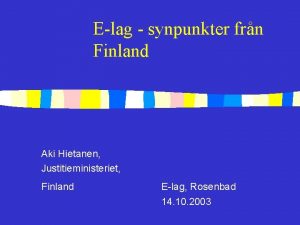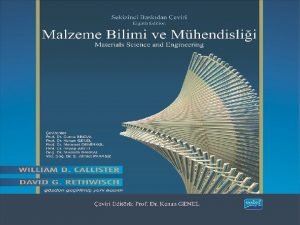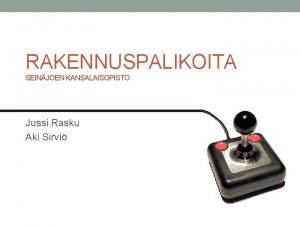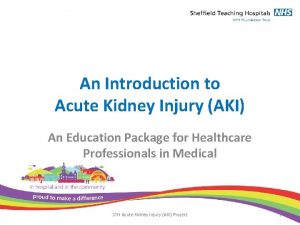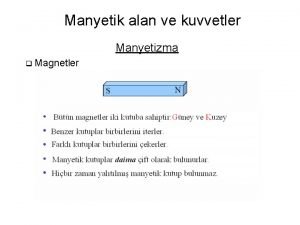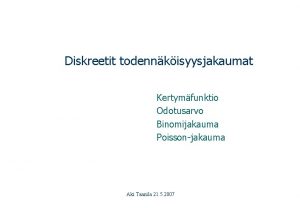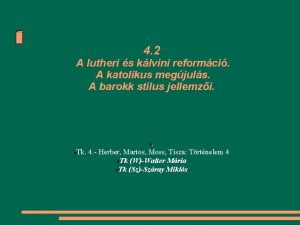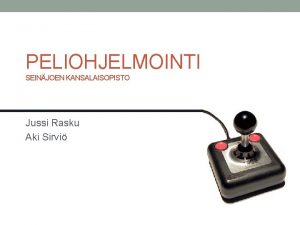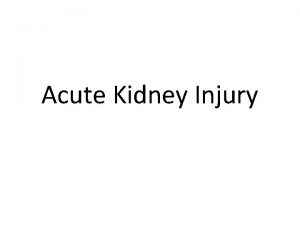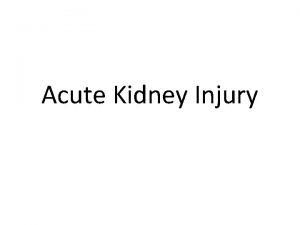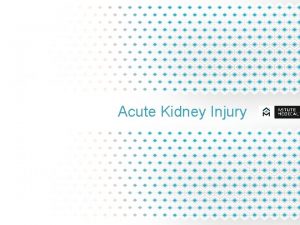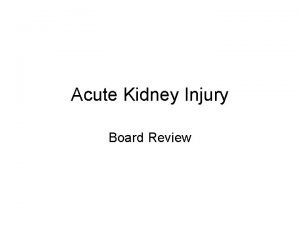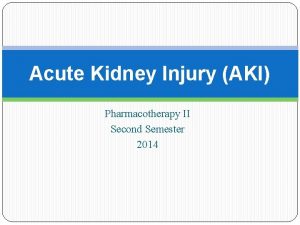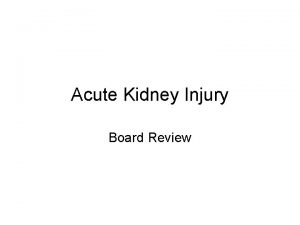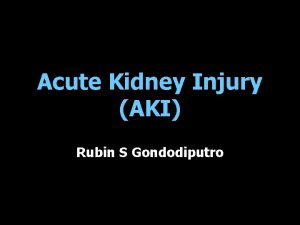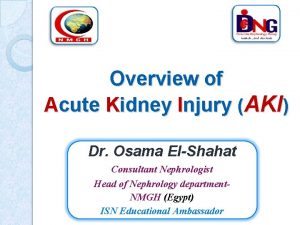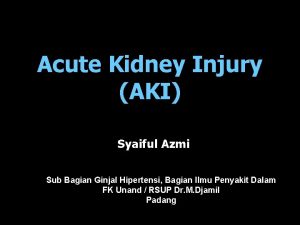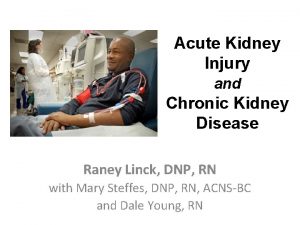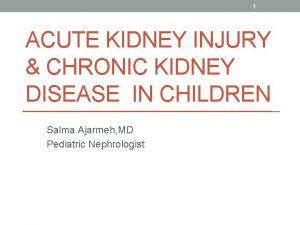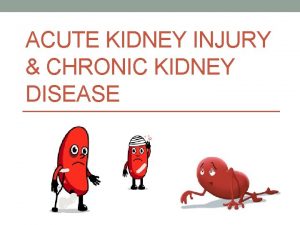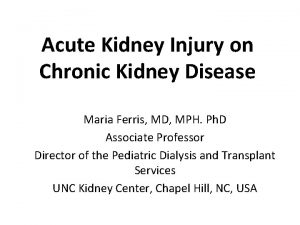Dialytic Support of Acute Kidney Injury AKI Dr

































- Slides: 33

Dialytic Support of Acute Kidney Injury (AKI) Dr. Osama El Shahat Consultant Nephrologist Head of Nephrology department NMGH (Egypt)

Objectives When to start ? What Modality ? HOW can we do it ?

What is the advantages of RIFLE Criteria? Ø Applying the RIFLE criteria revealed new insights. Ø Firstly, the RIFLE classification is feasible and fairly straightforward. Ø Secondly, the patients categorized as RIFLE F had a far higher mortality than RIFLE I and R patients. Max Bell et al; Nephrol Dial Transplant 2005 20: 354 – 360

Stage based management AKI Stage General Principles Stage 1 (Risk) Risk for more severe AKI Monitor (prevent progression) Stage 2 (Injury) H igh k s i R 1 2 isk Inj R ury 3 re ilu Fa Discontinue all nephrotoxic agents when possible Ensure volume status and perfusion pressure Consider functional hemodynamic monitoring Monitoring Serum creatinine and urine output Avoid hyperglycemia Consider alternatives to radiocontrast procedures Risk of AKI related mortality/morbidity high Conservative therapy) Non invasive diagnostic workup Consider invasive diagnostic workup Check for changes in drug dosing Stage 3 (Failure) Highest risk of death Consider RRT Consider Renal Replacement Therapy Consider ICU admission Avoid subclavian catheters if possible

When to start ?

Indications for RRT in critically ill AKI patients Renal Indications Life-threatening indications Hyperkalemia Metabolic Acidosis Pulmonary edema Uremic omplications

Dialysis Interventions for Treatment of AKI 5. 1. 1: Initiate RRT emergently when lifethreatening changes in fluid, electrolyte, and acid-base balance exist. (Not Graded) 5. 1. 2: Consider the broader clinical context, the presence of conditions that can be modified with RRT, and trends of laboratory tests—rather than single BUN and creatinine thresholds alone— when making the decision to start RRT. (Not Graded)

When to start RRT ? Crit Care Med 2008, Vol. 36, No 4 (suppl. ) Early RRT seems better

What Modality ?

Renal Replacement Therapy in AKI 1. Peritoneal dialysis (PD) 2. Intermittent Hemodialysis (IHD) 3. Slow Low Efficiency Dialysis (SLED) 4. Continuous Renal Replacement Therapy (CRRT) • Slow Continuous Ultrafiltration (SCUF) SCUF • Continuous Venovenous Hemofiltration (CVVH) CVVH • Continuous Venovenous Hemodialysis (CVVHD) CVVHD • Continuous Venovenous Diafiltration (CVVHDF) CVVHDF

Peritoneal Dialysis (PD) In Ak. I Advantages ØHemodynamic stability ØSlow correction ØEasy access placement ØNo Anticoagulation ØTolerated in children Disadvantages ØRisk of infections ØDifficulty to use with abdominals surgery ØLogestics


GUIDELINE A 1: A 1 Suitability of peritoneal dialysis for AKI in adults A 1. 1 Peritoneal dialysis should be considered as a suitable method of continuous renal replacement therapy in patients with acute kidney injury (1 B).

What are the modalities of CRRT ? Mode of therapy Principle method of solute clearance CVVH Convection CVVHD Diffusion CVVHDF Convection & Diffusion SCUF Ultrafiltration (fluids)

Potential Advantages of CRRT Homodynamic stability Recovery of renal function Brain edema Biocompatibility Removal of cytokines Nutritional support Correction of metabolic acidosis

CVVH Avoids Hypertensive Episodes Ronco C et al Kidney Int 56 ( suppl 72 ) s 8 s 14 , 1999

Dialysis Interventions for Treatment of AKI 5. 6. 2: We suggest using CRRT, rather than standard intermittent RRT, for hemodynamically unstable patients. (2 B) 5. 6. 1: Use continuous and intermittent RRT as complementary therapies in AKI patients. (Not Graded

Recovery from ARF in IHD vs CRRT Study Modality % recovering renal function SUPPORT IHD* 67%** Morgera et al. CRRT 90% Ronco et al. CRRT 90% Mehta et al. IHD CRRT 59% 92% BEST Kidney† IHD CRRT 65% 89%

Role of CRRT in management of ICP Davenport, A Sem Dialysis, 2009 5. 6. 3: We suggest using CRRT, rather than intermittent RRT, for AKI patients with acute brain injury or other causes of increased intracranial pressure or generalized brain edema. (2 B) KDIGO® AKI Guideline March 2012

Removal of Cytokine The elimination of Ø inflamatory mediator occurs only during the 1 st hour after application of new filter. Cytokines removal Ø capacity of curently available membranes hardly matches the productin observed in severly affected septic patients De Vriese As JAM Soc Nephrol 10 846 853 1999 .

Is their an alternative to CRRT ? Slow Low Efficiency Daily Dialysis (SLED) SLED Ø Typically performed over 6 -12 hours Ø Can be performed with a conventional dialysis machine – A little less labor intensive – Requires less training/startup Fliser D and Kielstei JT Nat Clin Pract Nephrol, 2006

Slow Low Efficiency Daily Dialysis (SLED) Ø Major advantages: flexibility, reduced costs, low or absent anticoagulation Ø Similar adequacy and hemodynamics üOne small study (16 pts) showed slightly higher acidosis and lower BP (Baldwin 2007) üVA trial (Palevsky NEJM 2008) suggests similar outcomes as CRRT and IRRT. Vanholder et al. Critical Care 2011, 15: 204

How we can do it ? Processes of care, more pertinent to Nephrologists: ü Vascular Access ü Membrane characteristics ü Solution ü Anticoagulation ü Dose

Vascular access 5. 4. 1: 5. 4. 1 We suggest initiating RRT in patients with AKI via an uncuffed nontunneled dialysis catheter, rather than a tunneled catheter. (2 D) 5. 4. 2: 5. 4. 2 When choosing a vein for insertion of a dialysis catheter in patients with AKI, consider these preferences (Not Graded): Ø First choice: right jugular vein; Ø Second choice: femoral vein; Ø Third choice: left jugular vein; Ø Last choice: subclavian vein with preference for the dominant side. KDIGO® AKI Guideline March 2012

Solutions for CRRT Bicarbonate versus lactate based fluid replacement in CVVH Prospective, randomized study Results : Serum lactate concentration was significantly higher and the bicarbonate was lower in patients treated with lactate based solutions Increased incidence of CVS events in pts ttt with lactate solution ◦ Hypotension ◦ Increased dose of inotropic support barenborck and colleague Barenbrock M et al; Kidney Int (2000

Dialysis Interventions for Treatment of AKI 5. 7. 3: 5. 7. 3 We suggest using bicarbonate, rather than lactate, as a buffer in dialysate and replacement fluid for RRT in patients with AKI and liver failure and/or lactic acidemia. (2 B) KDIGO® AKI Guideline March 2012

The Membrane High Flux membrane , synthetic , biocompatable , acting by providing both methods of detoxications: a) Diffusion : for low molecular weight toxins. b) Convection : for large molecules. 5. 5. 1: We suggest to use dialyzers with a biocompatible membrane for IHD and CRRT in patients with AKI. (2 C) KDIGO® AKI Guideline March 2012

Anticoagulation Modality Advantages Disadvantages Heparin Good anticoagulation Thrombocytopenia bleeding LMWH Less thrombocytopenia bleeding Citrate Lowest risk of bleeding Metabolic alkalosis, hypocalcemia special dialysate Regional Heparin Reduced bleeding Complex management Saline flushes No bleeding risk Poor efficacy Prostacycline Reduced bleeding risk Hypotension poor efficacy

5. 3. 2. 1: 5. 3. 2. 1 For anticoagulation in intermittent RRT, we recommend using either unfractionated or low-molecular weight heparin, rather than other anticoagulants. (1 C) 5. 3. 2. 2: 5. 3. 2. 2 For anticoagulation in CRRT, we suggest using regional citrate anticoagulation rather than heparin in patients who do not have contraindications for citrate. (2 B) KDIGO® AKI Guideline March 2012

Dose Optimal intensity of RRT is controversial Ø RCT of 1124 critically ill pts with AKI and sepsis or at least one organ failure to intensive or less intensive renalreplacement therapy Hemodynamically unstable pts received CRRT or SLEDD, Ø Stable pts IRRT ü Intensive RRT= IRRT or SLEDD 6 x/wk or CRRT at 35 ml/kg/hr ü Less intensive RRT= IRRT or SLED 3 x/wk or CRRT at 20 ml/kg/hr Ø VA/NIH Acute Renal Failure Trial Network. (NEJM 2008; 359: 7):

No difference in mortality VA/NIH Acute Renal Failure Trial Network. (NEJM 2008; 359: 7):

Conclusions ü Data ü The from high quality RCTs are lacking current trend is to provide RRT earlier ü There may be a recovery advantage to using CRRT vs. HD for initial management of AKI but no difference on mortality ü Dose: No benefit to “intensive” therapy Dialytic Support of AKI = Individualization

Thank YOU
 Acute kidney injury
Acute kidney injury Aki kifelé tekint álmodik aki befelé az ébred
Aki kifelé tekint álmodik aki befelé az ébred Battering intentional or unintentional
Battering intentional or unintentional Aki stages
Aki stages Frame semantics
Frame semantics Aki ira
Aki ira Likisi
Likisi Proyecto aki
Proyecto aki Kdigo aki classification
Kdigo aki classification Aki sorsa
Aki sorsa Istennek fia aki született
Istennek fia aki született Akı formülü
Akı formülü Manyetik akı
Manyetik akı Aki security training
Aki security training Aki bosnian boy
Aki bosnian boy Aki niemi
Aki niemi Shews score
Shews score Menhir cihunjuran
Menhir cihunjuran Aki hietanen
Aki hietanen Kdigo 2012 clinical practice guideline
Kdigo 2012 clinical practice guideline Manyetik akı formülü
Manyetik akı formülü és aki száz meg százezret rabolt
és aki száz meg százezret rabolt Jussi rasku
Jussi rasku Célhatározói mellékmondat
Célhatározói mellékmondat Skt aki
Skt aki Manyetik kuvvet
Manyetik kuvvet Binomijakauma
Binomijakauma Nem azert szeretlek aki vagy hanem
Nem azert szeretlek aki vagy hanem Aki parviainen business finland
Aki parviainen business finland Bárki aki társaságunkban melyet jézusról
Bárki aki társaságunkban melyet jézusról Aki rasku
Aki rasku Major details and minor details
Major details and minor details Kidney pyramid labeled
Kidney pyramid labeled Nursing management of hydronephrosis
Nursing management of hydronephrosis
